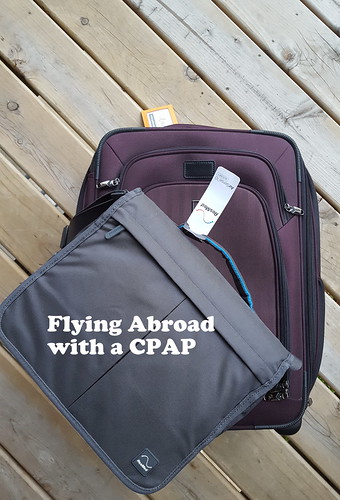Flying Abroad with a CPAP
If you have sleep apnea, you've probably worried about ways to travel with your CPAP. It is critical for your health (and your sleep)! I use a CPAP, have for years, and have been researched about traveling overseas with a CPAP for our trip to Ireland and Scotland. There are some good articles out there, but the most comprehensive resource is the US Department Of Transportation's Steps Taken to Ensure New Security Requirements Preserve and Respect the Civil Rights of People with Disabilities. As the American Sleep Apnea Association notes, it is a good idea to print out the DOT's fact sheet and be prepared to show it to airport personnel.

We interviewed two experts about traveling with a CPAP - Candy Harrington, the guru of accessible travel, and Rosemarie Curran, of Aer Lingus (on which we'll be flying from Shannon to Glasow).
Here's what Rosemarie had to say about traveling with a CPAP on Aer Lingus...
WE: What accommodations do you provide for travelers with a CPAP?
RC: Aer Lingus adheres to the DOT regulations that require passengers traveling with a CPAP travel with an FAA approved machine. The machine needs to be labeled as FAA approved. There is no carry-on fee for the machine.
The passenger must also provide a note from their physician (dated within 10 days of travel) to advise that they are able to travel.
Passengers are not able to plug in the machine, however they should have sufficient battery power to last 150% of the flight (in case of delays, etc.)
WE: do you have any advice for people with these disabilities?
RC: Please contact us with the information when you make your booking or as soon as you have your requirements together. When contacting us, provide detailed information regarding your specific, individual needs. This will ensure that we will be able to assist an effective and efficient manner.
http://www.aerlingus.com/help/help/specialassistance/
~~~~~~~~~~~~~~~~~~~~~~~~~~~~~~~~~~~~~~~~~~~~~~~~~~~~~~
Known as the guru of accessible travel, Candy Harrington has covered this niche exclusively for the past 15 years. She’s the founding editor of Emerging Horizons and the author of several accessible travel titles, including the classic, Barrier Free Travel: A Nuts and Bolts Guide for Wheelers and Slow Walkers - you can read our review and interview here. She also has advised us on traveling with a mobility disability in Ireland and Scotland.
Tape measure in hand, Candy hits the road often, in search of new accessible travel options. She also blogs regularly about accessible travel news, resources and industry updates on her Barrier Free Travels blog at http://barrierfreetravels.com/.
Here's what Candy had to say about traveling with a CPAP...
WE: Traveling with a CPAP can be stressful, worrying about electricity, baggage, etc. Do you have any travel tips for traveling with a CPAP?
CH: When you're traveling overseas with a CPAP, I think the trickiest thing is remembering to pack along adapters AND a converter. I know too many people who have simply plugged their machines into the socket (used an adapter and no converter) and fried their batteries.
This also happens with scooters and power wheelchairs. Just because the plug fits, doesn't mean it's OK to plug it in. Adapters merely make the plugs fit. Converters convert the electricity so there will be no damage. If you use the former without the latter, you'll be in big trouble. Always think before you plug in!
WE: How can travelers that require a CPAP make sure their machine stays safe (thinking airlines!)...
CH: Quite simply, don't let it out of your sight -- take it along with you in the cabin as carry-on luggage. Additionally, if you will need to use it along the way, you have to give the airlines 48 hours notice. You must also carry along enough batteries to power the device for 150% of the flight time, and they must be packaged appropriately (in the machine or original package is best). And of course the machine must be approved for in-flight use. The airlines are also required to give you specifications on allowable dimensions and weight, so contact your carrier for that information.
WE: Anything else you'd like to share with us?
CH: I would also pack along a power strip and an extension cord. Sometimes outlets are limited in hotels, and they may not be close to the bed.
Additionally, I would contact the manufacturer of your machine and ask them where you can get it serviced at your destination, just in case you run into problems. Chances are everything will be fine, but having this information at your fingertips will save time, should an emergency arise. Plus it gives you a little more confidence and some peace of mind.
WE: Thanks so much, Rosemarie and Candy!
-

- Log in to post comments



















